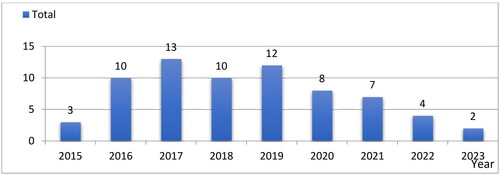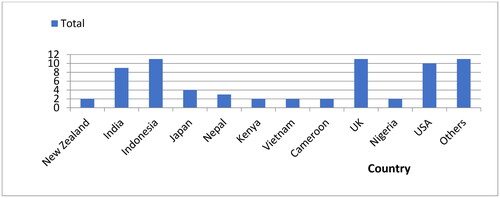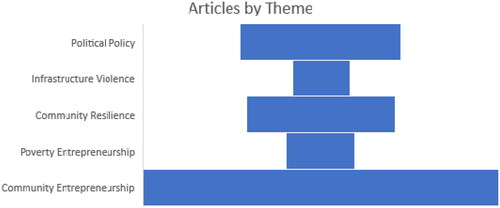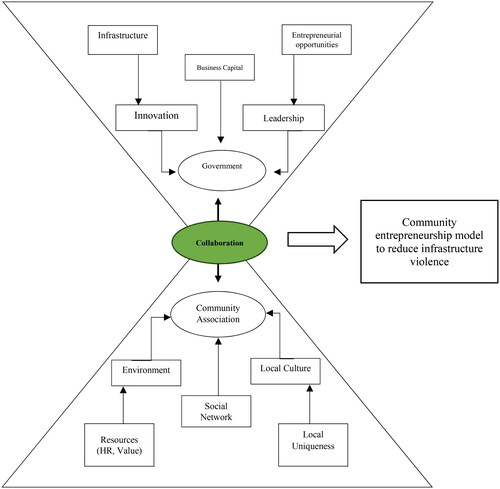Abstract
This article is related to the understanding of the importance of the political community to create entrepreneurial policies (policy politics). This is one of the solutions to overcome infrastructure violence in road construction through community empowerment, in order to realize sustainable infrastructure development. The research method uses a qualitative approach using a systematic literature review (SLR). SLR was conducted using the PRIMA method, collecting data from various journal articles sourced from Google Scholar, Science Direct, and other relevant articles. These articles were collected based on the last ten years of information explaining the political concept of community entrepreneurship policy, the concept of infrastructure violence, and the importance of community entrepreneurship in reducing risk and violence associated with road construction. These articles contribute to providing knowledge development insights on the policy politics of community entrepreneurship in addressing infrastructure violence in road construction and relevant research topics for the future.
Reviewing Editor:
Introduction
Infrastructure development is an effort made by the government or state to achieve public welfare (Alam & Kumar, Citation2013; Berawi, Citation2016; Putri et al., Citation2021; Rusim et al., Citation2019). Road infrastructure development is also an integral part of this effort. The purpose of road infrastructure development is to facilitate the community in carrying out activities and mobility to achieve a better life (Akimura, Citation2015; Kanwal et al., Citation2020; Rakhimberdinova, Citation2014; Rusim et al., Citation2019; Yu, Citation2017). However, in its implementation, the development of road infrastructure in various countries in the world (developing or developed countries) has actually caused negative impacts on the community itself. These impacts include environmental pollution (Hidayat, Citation2010); ecosystem damage and biodiversity (Kadarisman et al., Citation2015); soil damage (Bensi et al., Citation2015) and soil structure (Chehlafi et al., Citation2019; Palomino & Parvania, Citation2019); loss of local livelihoods (Cernea & Schmidt-Soltau, Citation2006; Laterrasse, Citation2019); loss of community assets (Ding, Citation2007; Hall & Savage, Citation2019; Meadows et al., Citation2019; Reyes-García et al., Citation2020); community isolation and social disarticulation (Cernea, Citation2008; Sapkota, Citation2000).
Although efforts have been made by various parties in each country to overcome these impacts, the negative impacts of road construction in the long run cannot be completely eliminated. Moreover, these impacts are very detrimental to the affected communities. Among the most significant impacts are social impacts because these impacts are difficult to detect and measure rationally, due to other influencing factors such as systemic or structural, cultural and socio-political factors (Putri et al., Citation2021, Citation2023; Rodgers & O’Neill, Citation2012). Furthermore, the negative impact of road infrastructure development, especially from the social aspect, has developed into infrastructure violence.
Infrastructure violence is the way infrastructure (regulatory, structural, technological, social, cultural, economic, and political) works that creates destructive conditions, especially for marginalized communities (Rodgers & O’Neill, Citation2012). Furthermore, this passive infrastructural violence is affirmed by other scholars as slow violence, i.e. violence that occurs gradually and invisibly, delayed destruction violence that is dispersed in time and space, frictional violence that is usually invisible as violence (Truelove & Ruszczyk, Citation2022).
Infrastructure violence as a result of road infrastructure development can be addressed through a decision-making process by the political community (Putri et al., Citation2023a). The political community is defined as the government accountable to the citizens, and the citizens under the government - one of the most important institutions in contemporary life for realizing distributive justice (Christiano, Citation2008). The government can carry out a decision-making process to fight for the interests of society democratically (policy politics) (Putri et al., Citation2023a). Policy politics is a concept that clearly identifies the role of political actors, including society; government; private sector, proportionally in the political process to produce the best decision in public decision making (Putri & Helmi, Citation2023). The politics of policy can also be understood as a process or flow that identifies the role of actors in formulating mutually beneficial political decisions in certain activities, such as in the fields of economy; education; transportation and so on. (Lawinsider, Citation2015) Political policies to overcome infrastructure violence can be pursued with a pattern of community-based entrepreneurship and this is considered to reduce the risk of infrastructure development that occurs.
Entrepreneurship is an endeavor that connects people with the process of value creation or the process of innovation that produces new businesses by individuals through the recognition of opportunities (Silfia et al., Citation2020). Entrepreneurship is also one of the solutions to overcome community poverty caused by the negative impacts of development (such as infrastructure violence), for example through the management of start-ups (Morris et al., Citation2020) and adopt technology in the development of community creativity (Cornwall, Citation1998; Neumeyer et al., Citation2021; Santos & Neumeyer, Citation2023). Furthermore, the entrepreneurial pattern cannot be separated from community involvement and a supportive environment (Gurău & Dana, Citation2018). This is in order to realize a community-based entrepreneurship policy, because the top-down pattern from the government alone is considered unsuccessful in realizing good entrepreneurship so that it must be done through community-based entrepreneurship (community entrepreneurship) (Gurău & Dana, Citation2018; Neumeyer et al., Citation2019).
Community entrepreneurship is an effort made to improve people’s lives by empowering local resources, leadership, and communal values to achieve a better community economy (Matthias Fink et al., Citation2013). Community entrepreneurship is also defined as a community’s efforts to shape entrepreneurial action at local and regional levels through culture, leadership, institutions, policies, history and narratives, and beliefs about what is possible (Fortunato & Alter, Citation2015; Hindle, Citation2010). Community entrepreneurship requires a role for government in policy formulation, planning and problem solving to address community issues, including those related to the impacts of development (Elwood, Citation2006). Community entrepreneurship is carried out as an effort to anticipate the occurrence of bad entrepreneurship. In this regard, there is the concept of poor entrepreneurs, namely the condition of people experiencing poverty so that community entrepreneurship is needed to help poor people get out of economically depressed conditions due to financial limitations (Slade Shantz et al., Citation2018). Community entrepreneurship can reduce poverty in the community by mobilizing the potential of the local community, for example through the development of local industries independently (Spilling, Citation2011).
Various solutions to overcome these problems have been implemented and studied by experts, such as the public-private partnership system in road infrastructure development (Enright, Citation2007; Joesoef, Citation2021; Mun, Citation2019; P. O’Brien et al., Citation2018); environmental studies and socio-ecological mitigation (Kumari & Sharma, Citation2017; Rahmawati & Tenriajeng, Citation2020; Rusim et al., Citation2019); efforts to improve community social conditions by studying social risks (Desdemoustier et al., Citation2019; Kampová, Citation2010; Mares, Citation2003; Turner, Citation2018); including efforts to make road infrastructure development policy decisions that accommodate community participation through the concept of green infrastructure (Maes et al., Citation2012; Steele & Legacy, Citation2017). However, these studies have yet to provide solutions that touch the grassroots level and provide tangible benefits to affected communities.
The research gap of this study is that infrastructure violence that has occurred in toll road construction has been tried to be anticipated by previous experts as explained in the previous paragraph (Desdemoustier et al., Citation2019; Enright, Citation2007; Joesoef, Citation2021; Kampová, Citation2010; Kumari & Sharma, Citation2017; Maes et al., Citation2012; Mares, Citation2003; Mun, Citation2019; P. O’Brien et al., Citation2018; Rahmawati & Tenriajeng, Citation2020; Rusim et al., Citation2019; Steele & Legacy, Citation2017; Turner, Citation2018), However, the things offered or explained by them in fact in the field have not shown significant results. Therefore, this article explains that there must be other alternative ideas that can be implemented in the field so that infrastructure violence in toll road construction can be reduced or even eliminated. The alternative is to involve the community proportionally in the decision-making process to produce social entrepreneurship policies for communities affected by toll road construction.
This is done because so far, the involvement or participation of affected communities in the decision-making process is not widespread, especially in seeking community resilience to the conditions they face, even though such involvement is very important to produce comprehensive policies. Community resilience can be achieved by the government by involving people in decision-making to change their living conditions by engaging in activities in their communities (Kelly et al., Citation2015). The results of these decisions can create policies that benefit the community both socially and economically, conceptually categorized as an effort to conduct community entrepreneurship to reduce infrastructure violence.
From the explanation above, the research question is how to find an alternative solution formula to overcome infrastructure violence in toll road construction, which will later give birth to novelty in conceptual form which also leads further researchers to conduct research related to several things, for example, it can be stated through further research questions. The follow-up research question is related to building relationships with the community (collaboration with society), as a key aspect in formulating community entrepreneurship policies that are a hybrid between top-down and bottom-up decision-making patterns, to minimize infrastructure violence for communities affected by road construction.
Literature
Infrastructure violence
Infrastructure violence is the way infrastructure (regulatory, structural, technological, social, cultural, economic and political) works to create destructive conditions, especially for marginalized communities (Rodgers & O’Neill, Citation2012). This infrastructural violence can be divided into two: active and passive infrastructural violence. Active violence relates to the appropriation and deployment of infrastructure by elite bodies as population guards that regulate and differentiate the social and territorial relations of the poor and the elite (Rodgers & O’Neill, Citation2012). While passive infrastructure violence is a socially harmful effect that stems from infrastructure limitations and omissions rather than direct consequences (Rodgers & O’Neill, Citation2012). Furthermore, passive infrastructure violence is emphasized by other experts as slow infrastructure violence, which is violence that occurs gradually and invisibly, delayed destructive violence spread over time and space, attrition violence which is usually not seen as a violence (Truelove & Ruszczyk, Citation2022).
Decision making process
The decision-making process in the context of this research is a political decision-making process, so the concept of decision-making described is part of the political process. Politics as a science discusses several aspects, including the State; power; decision-making; public policy and distribution (Budiardjo, Citation2008). The state as the core of politics focuses on state institutions and their formal form. Decision-making as the main concept of politics concerns decisions that are taken collectively and that bind the whole society. Wisdom (policy) is a collection of decisions taken by an actor or by a political group in an effort to choose goals and ways to achieve these goals. The decision-making process is a selection of policy alternatives carried out by policy makers based on rational considerations and paying attention to normative values for the public interest (Putri et al., Citation2023b).
The decision-making process can be seen from the process, which consists of a top-down process model and a bottom-up model. The top-down model is a model based on the government’s decision, because they have resources (power, funds and strength) (Rustiadi et al., Citation2018). While the bottom-up model is a decision-making process model that involves the community as an important part of listening to their aspirations (Lebeau et al., Citation2018; Visser et al., Citation1999). When these models operate in isolation, it is assumed that the resulting political decisions are not good enough. The process should be used simultaneously - a collaboration of the two models, so that related to the research conducted will produce political policies that can reduce infrastructure violence.
Community entrepreneurship
Entrepreneurship is a set of behaviors that are constrained, guided, enhanced, and limited by the social, economic, and environmental context in which entrepreneurs find themselves (Fortunato & Alter, Citation2015). Entrepreneurial activities are not only oriented towards increasing economic profits but also foster interest in developing community creativity which can later improve their welfare (Anderson & Gaddefors, Citation2016). Entrepreneurial activities that involve communities to release the shackles of their economic problems that cannot be overcome by the government and the conventional private sector lead to an understanding of community entrepreneurship. Community entrepreneurship can mediate the relationship between community culture, social and economic development. (Anderson & Gaddefors, Citation2016). This community entrepreneurship is categorized by some experts as social entrepreneurship, which is the activity of agents or groups or communities that play a role of change supported by the value of creativity and innovation without eliminating the culture and participation of their community with economic goals and social missions (Sartono & Sutrismi, Citation2020).
Related to efforts to overcome infrastructure violence in toll road development, social entrepreneurship can be pursued through community benefit agreement (CBA) commitments (Putri et al., Citation2021), among others on the creation of exit tolls; priority management of rest areas to affected communities through micro, small and medium enterprise (MSME) programs; local tourism management.
As of this writing, if the negative impacts of road infrastructure development are ignored, then there is infrastructure violence against communities, as they are most at risk, economically, environmentally and socially. Therefore, sustainable road infrastructure development cannot be achieved. Therefore, the research hypothesis is that there is a relationship between entrepreneurial policies by the political community and the reduction of infrastructure violence in road development.
Methods
The method used in this research is a systematic literature review (SLR). SLR is a collection of articles on community entrepreneurship policy politics in infrastructure development from leading journals in various relevant online references (Alomoto et al., Citation2021; Macke & Genari, Citation2019; Muluk, Citation2021; Putri et al., Citation2021). SLR aims to identify the main theoretical aspects and highlight the main characteristics of the publications. SLR is based on grounded theory, to enable researchers to identify gaps in the field and build theoretical models based on the results that emerge (Macke & Genari, Citation2019).
The SLR process is divided into several stages, including:
Identifying articles based on the title, abstract, and keywords related to ‘policy politics; social entrepreneurship; infrastructure violence.
Selecting databases from www.sciencedirect.com, www.proquest.com, www.google.scholar.com, www.scopus.com, with journal categories in social humanities.
Searching for effective studies with a time range of 2010-2022, resulting in 90 articles. 71 relevant articles were selected from the 90 articles
Of the 90 relevant articles, 71 were included in the bibliography (61 journal articles and 10 from textbooks).
The selected abstracts are grouped and content analysis is conducted using the Publish or Perish 8 application.
The presentation of findings and analysis is based on the classification of definitions, time range, themes, country of publication, and the type of publication (journal or book).
The process flow of SLR can be seen in the PRISMA (Preferred Reporting Items for Systematic Review and Meta-Analysis) flowchart on :
Result and discussions
Result
The table above briefly explains the findings of the SLR on conceptual issues related to community entrepreneurship policy as an effort to address infrastructure violence ().
Based on the research search, it is known that out of 71 articles, the majority are dominated by articles sourced from scientific journals (61 articles), followed by sources from textbooks and others ().
The use of the publish or perish 8 as a search engine for articles in this study was limited to the publication year from 2015 to 2023. The search results described that articles related to community entrepreneurship policy were mostly found in 2016 and 2023 ().
The articles for this SLR research come from various countries around the world, both developed and developing countries, including articles from Indonesia ().
The above diagram shows that there are five major themes related to the research conducted, namely political policy; infrastructure violence; community entrepreneurship; poverty entrepreneurs; and community resilience ().
Discussion
Policy politics
Policy politics is the ability to achieve the goal of realizing a prosperous society through decision-making based on democratic principles in choosing the best alternative decision for the common interest. (Putri et al., Citation2023a). Community entrepreneurship policies relate to political actors, systems, and decision-making processes, related to efforts to improve the economies of individual actors, groups, or to influence decision-making for communities (T. O’Brien, 2019; Sobari, Citation2019). Of the three characteristics of community entrepreneurship politics proposed by experts, in this study community entrepreneurship politics refers to the decision-making process to make policies that can improve people’s lives. A decision-making approach that considers local culture, leadership and values in the community is considered capable of producing decisions that can support all elements of society in improving their lives, even without adequate financial resources. Community entrepreneurship can also minimize infrastructure violence in development, especially related to road construction.
Furthermore, the community entrepreneurship policy is also a solution to reduce poverty (Morris et al., Citation2020). So far, to help people escape poverty due to the negative impact of development, the government has issued entrepreneurship policies that tend to be top-down, but the results have not been able to overcome poverty significantly. This is because these policies have not supported people who have small or limited business capital to become entrepreneurs. So there must be a pattern of community empowerment (Spilling, Citation2011), by considering several aspects including infrastructure; entrepreneurs; opportunities, process differentiation; economic model design; resources, the collaboration of these aspects is also referred to as the SPODER framework (Morris et al., Citation2020). Good infrastructure helps build community entrepreneurship, making it easier to prepare entrepreneurs. In addition, business opportunities are built together based on local cultural and environmental characteristics (Gurău & Dana, Citation2018), This is also a business differentiator with other entrepreneurs who have different characteristics and capital. The business differentiator in question is more about the ability to innovate by prioritizing local culture and characteristics and is unique. So that even though the capital is limited, the business can survive. Especially if supported by a community with a strong social attachment base through providing opportunities, mentoring, coaching, training and so on.
The framework of community entrepreneurship development as an effort to overcome the negative impact of infrastructure development or infrastructure violence is shown in the following figure:
Based on the figure above, it is known that stakeholders in the political community consisting of the government and the community have different potentials to develop community entrepreneurship. On the basis of this potential, the politics of community entrepreneurship policies implemented in the decision-making process by stakeholders must refer to . In , it is known that there is synergy to build community-based entrepreneurship and not dominated by the government (top-down), but collaboration between various opportunities and opportunities to realize community entrepreneurship that is able to overcome poverty and generally support the implementation of infrastructure development (roads) for community resilience.
Community resilience as a political policy agenda for entrepreneurship in development
The community entrepreneurship policy described earlier cannot run optimally if community associations do not empower themselves and are actively involved in realizing community entrepreneurship. Community participation is needed to encourage the realization of the community entrepreneurship policy agenda to overcome infrastructure violence. Among the empowerment patterns is to strengthen the resilience of the community so that the negative impact of development is no longer an obstacle but an opportunity to survive and get out of adversity and poverty. (Spilling, Citation2011).
According to Magis, community resilience is the presence, development, and engagement of community resources by community members to thrive in an environment characterized by change, uncertainty, and surprise (Kelly et al., Citation2015). Resilient community members intentionally develop personal and collective capacities to respond to and influence change, to sustain and renew the community, and to develop new pathways for the community’s future (Kelly et al., Citation2015). Related to infrastructure development, studies on community resilience have been discussed from various perspectives such as community resilience to natural disasters and climate change; coastal community resilience; collective action and community resilience; community resilience and globalization processes; the difference between community resilience and ecological resilience; socio-ecological resilience and land degradation resilience (Kelly et al., Citation2015). However, the relationship between community resilience and the politics of community entrepreneurship policy has not been widely discussed by experts. The community resilience referred to in this paper is the efforts of affected communities to respond to and influence change through their involvement to support the economic and social progress of their communities (community entrepreneurship).
Community resilience in the face of infrastructure violence from toll road development begins with community involvement in responding to, and influencing, the changes brought about by the development. The community cannot walk alone to overcome the impact of infrastructure violence. From a number of previous studies, the active role of the community is the main capital to realize resilience. Communities that are members of associations make them a well-structured organization to respond to all government policies and their impacts.
Furthermore, environmental factors and local culture also strengthen community resilience in facing the impacts of development. Communities have a unique culture or local wisdom in each region to survive various obstacles in continuing their lives which come from their habits, customs or religious beliefs. All of these things synergize with each other and provide a good picture to be used as a response to the impact of Community policies. An example of community resilience in the face of infrastructure violence is collaboration through joint capital for social entrepreneurship activities managed by cooperative institutions in an area. This aims to keep the community’s economic activities running well.
Furthermore, this article explains the key factors that influence community resilience. Factors that influence community resilience include economic factors, such as government policies that prioritize employment opportunities for affected communities. Social factors, as they mediate the relationship between socioeconomic components and the existing system environment, include the level of interaction between community members, such as trust, relationships, conflict resolution processes, youth and parental involvement, learning and communication channels, cooperation, network strength, bonding capital, and community ‘cohesion’. Third, institutional factors include those closely related to politics, governance, and institutional bodies and structures. These are usually related to political will and the ability to implement effective policies to help communities cope with infrastructure and violence risks. Fourth, culture includes societal norms, conventions, traditions, rituals and ideologies. These components are among the most challenging and exciting processes that influence community resilience and can even influence decision-making processes in Communities. Finally, natural factors include soil type and quality, water availability and quality, terrain steepness and accessibility, climate (such as susceptibility to drought or not), and vegetation type. Based on the literature study, it was found that the five factors above have not fully embodied community resilience, especially with regard to encouraging the participation of affected communities in fostering a culture of community entrepreneurship, so it is necessary to add the concept of mobilizing local communities in decision-making, as a process of communities needing solutions to generate creative and innovative ideas to overcome infrastructure risks and violence in road construction. Local community mobilization is an orientation to increase the contribution of local communities in developing new ideas and strategies about community entrepreneurship based on the local environment or also known as local wisdom (Spilling, Citation2011).
Based on , it is known that to make decisions about community entrepreneurship policies in order to overcome infrastructure violence, it must start from strengthening the community. Communities affected by negative development must be actively involved by developing themselves for better change (resilience). Community resilience is the spearhead of community entrepreneurship development. There are aspects of local community mobilization that can complement the factors affecting community resilience to strengthen the potential for a strong community entrepreneurship model. If this can be done, then community entrepreneurship policies that are decided in a hybrid manner (joint decisions between the government and affected communities) will be proportional and become a solution to infrastructure violence.
Figure 7. Domains affecting public resilience as a component of public entrepreneurship policy. Source: Processed by the Researchers, 2023.
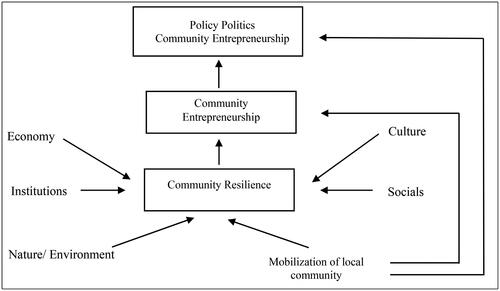
Based on the above arguments, the community entrepreneurship policy as an effort to overcome infrastructure violence is through policy politics that actively and proportionally involves the community. This activity can be seen through the process of community resilience. From some existing research, the concept of community resilience is influenced by several factors, including the economy; institutions; culture; social and natural environment. However, all of these factors have not yet embodied the political process of policy. So that to create a good community entrepreneurship policy, it is necessary to mobilize local communities to be involved in the entrepreneurial decision-making process to overcome infrastructure violence (as in ).
Furthermore, in addition to the above solutions, this paper contributes to generating several research questions for future research as a novelty of this article, among others ().
Conclusion
Systematic Literature Review (SLR) of entrepreneurship policies by political communities explains that community entrepreneurship policies are an important aspect in overcoming infrastructure violence in road construction. From the results of the study, it is known that efforts to overcome infrastructure violence through community entrepreneurship policies are through the concept of community resilience. Community resilience is based on strengthening change by prioritizing community participation. The community participation factor is also known as local community mobilization which is considered relatively influential compared to other aspects. Future research can examine aspects of community resilience that correlate with community entrepreneurship policies to overcome infrastructure violence in road construction in various countries, both developed and developing countries.
Disclosure statement
No potential conflict of interest was reported by the author(s).
Table 1. Main data collection terms.
Table 2. Future research questions.
References
- Akimura, S. (2015). Transportation statistics that can contribute to policies and social infrastructure development aimed at ensuring the healthy growth of cities and providing support for smooth economic activity. IATSS Research, 39(1), 1–13. https://doi.org/10.1016/j.iatssr.2015.06.001
- Alam, S. M. S., & Kumar, A. (2013). Sustainability outcomes of infrastructure sustainability rating schemes for road projects. Australasian Transport Research Forum. https://eprints.qut.edu.au/71695/
- Alomoto, W., Niñerola, A., & Pié, L. (2021). Social impact assessment: A systematic review of literature. Social Indicators Research, 161(1), 225–250. https://doi.org/10.1007/s11205-021-02809-1
- Anderson, A. R., & Gaddefors, J. (2016). Entrepreneurship as a community phenomenon; reconnecting meanings and place. International Journal of Entrepreneurship and Small Business, 28(4), 504–518. https://doi.org/10.1504/IJESB.2016.077576
- Bensi, M., Kiureghian, A. D., Asce, M., & Straub, D. (2015). Framework for post-earthquake risk assessment and decision making for infrastructure systems. ASCE-ASME Journal of Risk and Uncertainty in Engineering Systems, Part A: Civil Engineering, 1(1). https://doi.org/10.1061/AJRUA6.0000810
- Berawi, M. A. (2016). Accelerating sustainable infrastructure development: Assuring well-being and ensuring environmental sustainability. International Journal of Technology, 7 (4), 527. https://pdfs.semanticscholar.org/8cf9/2db8f30b936746d2482b7c7d46739a125742.pdf https://doi.org/10.14716/ijtech.v7i4.3829
- Budiardjo, M. (2008). Dasar-dasar Ilmu Politik edisi revisi (revisi). PT Gramedia Pustaka Utama.
- Cernea, M. M. (2008). IRR: An operational risks reduction model for population resettlement. Hydro Nepal: Journal of Water, Energy and Environment, 1, 35–39. https://doi.org/10.3126/hn.v1i0.883
- Cernea, M. M., & Schmidt-Soltau, K. (2006). Poverty risks and national parks: policy issues in conservation and resettlement. World Development, 34(10), 1808–1830. https://doi.org/10.1016/j.worlddev.2006.02.008
- Chehlafi, A., Kchikach, A., Derradji, A., & Mequedade, N. (2019). Highway cutting slopes with high rainfall erosion in Morocco : Evaluation of soil losses and erosion control using concrete arches. Engineering Geology, 260, 105200. https://doi.org/10.1016/j.enggeo.2019.105200
- Christiano, T. (2008). Immigration, political community, and cosmopolitanism. San Diego Law Review, 933–962.
- Cornwall, J. R. (1998). The entrpreneur as a building block for community. Jounal of Developmental Entrpreneurship, 3(2), 141–148.
- Desdemoustier, J., Crutzen, N., Cools, M., & Teller, J. (2019). Smart city apropriation by local actors: AN instrument in the making. Cities, 92, 175–186. https://doi.org/10.1016/j.sbspro.2014.11.031
- Ding, C. (2007). Policy and praxis of land acquisition in China. Land Use Policy, 24(1), 1–13. https://doi.org/10.1016/j.landusepol.2005.09.002
- Dupuis, A., Bruin, A. d., Cremer, R. D. (2003). Municipal-community entrepreneurship. In Entrepreneurship: New perspectives in a global age. Routledge. https://doi.org/10.4324/9781315190877-8
- Elwood, S. (2006). Beyond cooptation or resistance: Urban spatial politics, community organizations, and GIS-based spatial narratives. Annals of the Association of American Geographers, 96(2), 323–341. https://doi.org/10.1111/j.1467-8306.2006.00480.x
- Enright, D. J. (2007). The Public versus Private Toll Road Choice in the United States.
- Filardi, F., Castro, R. M. P. D., & Zanini, M. T. F. (2020). Advantages and disadvantages of teleworking in Brazilian public administration: analysis of SERPRO and Federal Revenue experiences. Cadernos EBAPE.BR, 18(1), 28–46. https://doi.org/10.1590/1679-395174605x
- Fortunato, M. W. P., & Alter, T. (2015). Community entrepreneurship development: an introduction. Community Development, 46(5), 444–455. https://doi.org/10.1080/15575330.2015.1080742
- Gurău, C., & Dana, L. P. (2018). Environmentally-driven community entrepreneurship: Mapping the link between natural environment, local community and entrepreneurship. Technological Forecasting and Social Change, 129, 221–231. https://doi.org/10.1016/j.techfore.2017.11.023
- Hall, J. D., & Savage, I. (2019). Tolling Roads to Improve Reliability. Journal of Urban Economics, 113(July 2018), 103187. https://doi.org/10.1016/j.jue.2019.103187
- Hidayat, I. W. (2010). Kajian Fungsi Ekologi Jalur Hijau Jalan sebagai Penyangga Lingkungan pada Tol Jagorawi. Jurnal Manusia Dan Lingkungan, 17(2), 124–133. https://doi.org/10.22146/jml.18711
- Hindle, K. (2010). How community context affects entrepreneurial process: A diagnostic framework. Entrepreneurship & Regional Development, 22(7-8), 599–647. https://doi.org/10.1080/08985626.2010.522057
- Joesoef, I. E. (2021). Rekonstruksi Pencabutan Hak Atas Tanah dan Konsinyasi dalam Pengadaan Tanah untuk Kepentingan Umum. Masalah-Masalah Hukum, 50(3), 318–330. https://doi.org/10.14710/mmh.50.3.2021.318-330
- Kadarisman, M., Gunawan, A., & Ismiyati, I. (2015). Implementasi Kebijakan Sistem Transportasi Darat dan Dampaknya terhadap Kesejahteraan Sosial di Jakarta. Jurnal Manajemen Transportasi & Logistik (JMTRANSLOG), 2(1), 59–78. https://doi.org/10.54324/j.mtl.v2i1.129
- Kampová, K. (2010). The concept of social risks perception [Paper presentation]. WIT transactions on information and communication technologies, 43 PART I (pp. 127–135). https://doi.org/10.2495/RISK100121
- Kanwal, S., Rasheed, M. I., Pitafi, A. H., Pitafi, A., & Ren, M. (2020). Road and transport infrastructure development and community support for tourism: The role of perceived benefits, and community satisfaction. Tourism Management, 77, 104014. https://doi.org/10.1016/j.tourman.2019.104014
- Karlsson, C., Silander, C., & Silander, D. (2016). Political entrepreneurship and entrepreneurship. In Political Entrepreneurship. Edward Elgar Publishing. https://doi.org/10.4337/9781785363504.00005
- Kelly, C., Ferrara, A., Wilson, G. A., Ripullone, F., Nolè, A., Harmer, N., & Salvati, L. (2015). Community resilience and land degradation in forest and shrubland socio-ecological systems: evidence from gorgoglione, Basilicata, Italy. Land Use Policy, 46, 11–20. https://doi.org/10.1016/j.landusepol.2015.01.026
- Kumari, A., & Sharma, A. K. (2017). Infrastructure financing and development: A bibliometric review. International Journal of Critical Infrastructure Protection, 16, 49–65. https://doi.org/10.1016/j.ijcip.2016.11.005
- Laterrasse, J. (2019). Transport and Town Planning, The City in Search of Sustainable Development. ISTE.
- Lawinsider. (2015). Political policy. https://www.lawinsider.com/dictionary/political-policy
- Lebeau, P., Macharis, C., Mierlo, J. V., & Janjevic, M. (2018). Improving policy support in city logistics: The contributions of a multi-actor multi-criteria analysis. Case Studies on Transport Policy, 6(4), 554–563. https://doi.org/10.1016/j.cstp.2018.07.003
- Macke, J., & Genari, D. (2019). Systematic literature review on sustainable human resource management. Journal of Cleaner Production, 208, 806–815. https://doi.org/10.1016/j.jclepro.2018.10.091
- Maes, J., Egoh, B., Willemen, L., Liquete, C., Vihervaara, P., Schägner, J. P., Grizzetti, B., Drakou, E. G., Notte, A. L., Zulian, G., Bouraoui, F., Luisa Paracchini, M., Braat, L., & Bidoglio, G. (2012). Mapping ecosystem services for policy support and decision making in the European Union. Ecosystem Services, 1(1), 31–39. https://doi.org/10.1016/j.ecoser.2012.06.004
- Mares, I. (2003). The politics of social risk, Cambridge University Press. https://doi.org/10.4018/978-1-7998-1791-8.ch002
- M., Fink, Loidl, & S., Richard. (2013). Community-based entrepreneurship and rural development. International Journal of Entrepreneurial Behavior and Research, X, 1–21.
- Meadows, J., Annandale, M., & Ota, L. (2019). Indigenous Peoples’ participation in sustainability standards for extractives. Land Use Policy, 88, 104118. https://doi.org/10.1016/j.landusepol.2019.104118
- Morris, M. H., Santos, S. C., & Neumeyer, X. (2020). Entrepreneurship as a solution to poverty in developed economies. Business Horizons, 63(3), 377–390. https://doi.org/10.1016/j.bushor.2020.01.010
- Muluk, M. R. K. (2021). Systematic literature review on asymmetric decentralization. BISNIS & BIROKRASI: Jurnal Ilmu Administrasi Dan Organisasi, 28(2) https://doi.org/10.20476/jbb.v28i2.1036
- Mun, S. (2019). Economics of transportation joint provision of transportation infrastructure. Economics of Transportation, 19, 100118. https://doi.org/10.1016/j.ecotra.2019.06.001
- Neumeyer, X., Santos, S. C., & Morris, M. H. (2019). Who is left out: exploring social boundaries in entrepreneurial ecosystems. The Journal of Technology Transfer, 44(2), 462–484. https://doi.org/10.1007/s10961-018-9694-0
- Neumeyer, X., Santos, S. C., & Morris, M. H. (2021). Overcoming barriers to technology adoption when fostering entrepreneurship among the poor: The role of technology and digital literacy. IEEE Transactions on Engineering Management, 68(6), 1605–1618. https://doi.org/10.1109/TEM.2020.2989740
- O’Brien, P., Pike, A., & Tomaney, J. (2018). Governing the ‘ungovernable’? Financialisation and the governance of transport infrastructure in the London ‘global city-region. Progress in Planning, 132, 100422. https://doi.org/10.1016/j.progress.2018.02.001
- O’Brien, T. (2019). Political entrepreneurship in the field of Māori sovereignty in Aotearoa New Zealand. The British Journal of Sociology, 70(4), 1179–1197. https://doi.org/10.1111/1468-4446.12611
- Palomino, A., & Parvania, M. (2019). Advanced charging infrastructure for enabling electrified transportation. The Electricity Journal, 32(4), 21–26. https://doi.org/10.1016/j.tej.2019.03.003
- Putri, N. E. (2020). Politik Kebijakan Infrastruktur: Tinjauan Pustaka Kebijakan Infrastruktur Transportasi Nora Eka Putri. Journal of Education on Social Science, 4(1), 14–24.
- Putri, N. E Helmi. (2023). Politik Kebijakan Pembangunan Jalan Tol: Integrasi Hybrid Policy dan Kewirausahaan Sosial. Amerta Media.
- Putri, N. E., Helmi, Noer., & M., Yossyafra. (2023a). Hybrid policy model in the land acquisition decision-making process for toll road project in West Sumatra, Indonesia. Academic Journal of Interdisciplinary Studies, 12(3), 250. https://doi.org/10.36941/ajis-2023-0075
- Putri, N. E., Helmi, H., Noer, M., & Yossyafra, Y. (2023b). The social and political factors on the decision-making process in land acquisition for sicincin-padang toll road construction, West Sumatera. JESS (Journal of Education on Social Science), 7(1), 40. https://doi.org/10.24036/jess.v7i1.461
- Putri, N. E., Helmi, Noer, & M., Yossyafra. (2021). Risk analysis and potential benefits of infrastructure development. MIMBAR : Jurnal Sosial Dan Pembangunan, 37(2), 236–248. https://doi.org/10.29313/mimbar.v37i2.6811
- Putri, N. E., Helmi, Noer., & M., Yossyafra. (2023). Social risk assessment of land acquisition for the construction of the Sicincin-Padang toll road section, West Sumatra, Indonesia. Kasetsart Journal of Social Sciences, 45(1), 167–180. https://doi.org/10.34044/j.kjss.2024.45.1.18
- Rahmawati, N., & Tenriajeng, A. T, Universitas Gunadarma. (2020). Analisis Manajemen Risiko Pelaksanaan Pembangunan Jalan Tol (Studi Kasus : Proyek Pembangunan Jalan Tol Bekasi-Cawang-Kampung Melayu). Rekayasa Sipil, 14(1), 18–25. https://doi.org/10.21776/ub.rekayasasipil.2020.014.01.3
- Rakhimberdinova, М. U. (2014). Investment in road infrastructure and regional economic development. Life Science Journal, 11, 162–165. http://citeseerx.ist.psu.edu/viewdoc/download?doi=10.1.1.1067.9323&rep=rep1&type=pdf
- Reyes-García, V., Fernández-Llamazares, Á., Bauchet, J., & Godoy, R. (2020). Variety of indigenous peoples’ opinions of large infrastructure projects: The TIPNIS road in the Bolivian Amazon. World Development, 127, 104751. https://doi.org/10.1016/j.worlddev.2019.104751
- Rodgers, D., & O’Neill, B. (2012). Infrastructural violence: Introduction to the special issue. Ethnography, 13(4), 401–412. https://doi.org/10.1177/1466138111435738
- Rusim, D. A., Parung, H., Latief, R. U., & Tjaronge, W. (2019). Risk analysis of time on road infrastructure development (Case study : Construction industry in Papua) Risk analysis of time on road infrastructure development (Case study : Construction industry in Papua). IOP Conference Series: Earth and Environmental Science, 235, 012077. https://doi.org/10.1088/1755-1315/235/1/012077
- Rustiadi, E., Saefulhakim, S., & Panuju, D. R. (2018). Perencanaan dan Pengembangan Wilayah. (A. E. Pravitasari, Ed.). Yayasan Pustaka Obor Indonesia.
- Santos, S. C., & Neumeyer, X. (2023). The technologization of entrepreneurial processes: A poverty perspective. IEEE Transactions on Engineering Management, 70(3), 1174–1185. https://doi.org/10.1109/TEM.2022.3195485
- Sapkota, N. (2000). Impoverishment risks and reconstruction in Kali Gandaki Dam, Nepal. High Plains Applied Anthropologist, 21(2), 147–156. http://www.hpsfaa.org/Resources/Documents/AppliedAnthropologist-2001/fall2001/Impoverishment Risks and Reconstruction of Kali Gandaki Dam, Nepal.pdf
- Sartono, S., & Sutrismi, S. (2020). Kewirausahaan; Kewirausahaan Komersial dan Sosial. Jurnal Benefit, 7(2), 94–102.
- Silfia, Helmi, Noer., & M., Henmaidi. (2020). Entrepreneurship for developing small and medium-scale farmers in agricultural clusters. Trikonomika, 19(2)
- Slade Shantz, A., Kistruck, G., & Zietsma, C. (2018). The opportunity not taken: The occupational identity of entrepreneurs in contexts of poverty. Journal of Business Venturing, 33(4), 416–437. https://doi.org/10.1016/j.jbusvent.2018.02.003
- Sobari, W. (2019). The practice of political entrepreneurship in a Rural Javanese village. Jurnal Ilmu Sosial Dan Ilmu Politik, 23(1), 30. https://pdfs.semanticscholar.org/96f5/c684ab060bcf6cb83413d57c593e99502734.pdf https://doi.org/10.22146/jsp.38420
- Spilling, O. R. (2011). Mobilising the entrepreneurial potential in local community development. Entrepreneurship & Regional Development, 23(1-2), 23–35. https://doi.org/10.1080/08985626.2011.540406
- Steele, W., & Legacy, C. (2017). Critical urban infrastructure. Urban Policy and Research, 35(1), 1–6. https://doi.org/10.1080/08111146.2017.1283751
- Truelove, Y., & Ruszczyk, H. A. (2022). Bodies as urban infrastructure: Gender, intimate infrastructures and slow infrastructural violence. Political Geography, 92, 102492. https://doi.org/10.1016/j.polgeo.2021.102492
- Turner, A. K. T. (2018). Social and environmental impacts of landslides. Innovative Infrastructure Solutions, 3(1), 25–27. https://doi.org/10.1007/s41062-018-0175-y
- Visser, J., Binsbergen, A. V., & Nemoto, T. (1999). Urban freight transport policy and planning [Paper presenation]. First International Symposium on City Logistics, July.
- Yu, H. (2017). Motivation behind China’s ‘One Belt, One Road’initiatives and establishment of the Asian infrastructure investment bank. Journal of Contemporary China, 26(105), 353–368. https://doi.org/10.1080/10670564.2016.1245894



